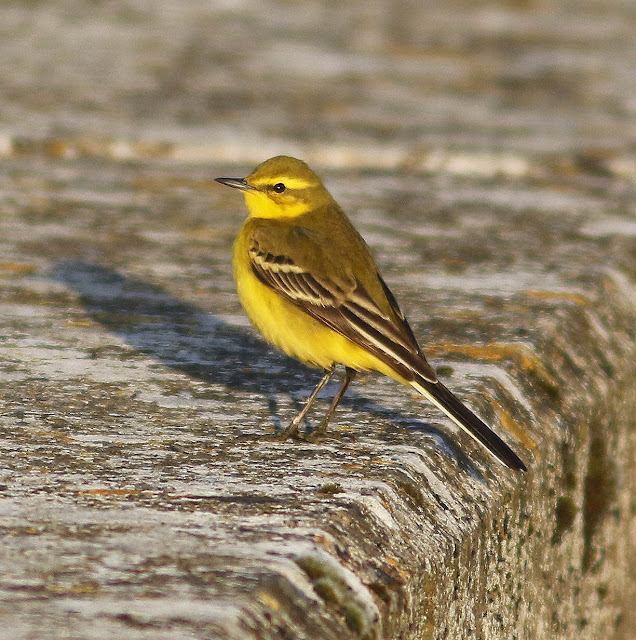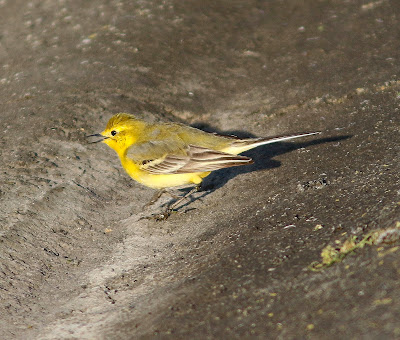It's the Spring Bank Holiday and predictably the weather takes a turn for the worse. However the Spring migrants do not care about such things, it is only us that complain. Farmoor Reservoir on Good Friday was cold, bleak and grey but at this time of year there is always the chance of migrant birds arriving at any time, so as usual I took to the central causeway, although it has to be said, more in hope than expectation.
Over a thousand Sand Martins and a few Swallows were feeding low over the reservoir. Quite a sight in its own right, the tiny forms of each bird flickering and twisting in rapid flight after the hatching flies, some even hovering to pick a fly from the surface of the water. Migration in action! The promise of renewal that we have all longed for through an almost unbearable winter of distress and concern.
Two thirds of the way up the causeway and, apart from the hirundines, I had only seen one Pied Wagtail. I looked further along the ribbon of concrete with my bins and was rewarded with the sight of two more wagtails, standing close to one another. These were different however, as there was no black and white in evidence but instead both were bright yellow. My first Yellow Wagtails of the year! It is always a joy to find them for the first time and every April the reservoir is graced with their presence, although in depressingly declining numbers but still they come, for now at least
I did not bother with photography but others did and got reasonable images but more tired than I cared to admit, after my long day in Cornwall yesterday, I contented myself with just watching and enjoying them. Yellow Wagtails, indeed all wagtails, exude a cheery aura that cannot fail to lift the spirit even on dull days such as this.Their pleasant calls, sociable nature and all round exuberance make it impossible not to feel energised. Add bright yellow plumage to the mix and I rest my case.
Walking further I met Andy and eventually we found six, all males, spectacular with golden yellow underparts and yellowish olive upperbodies.They are very smart birds at this time of year, for the yellow and olive is set off against a black tail and wing coverts, fringed in both cases with white.What is there not to like? Surely the males are one of the most colourful of our British birds when in their summer breeding plumage?
I went to reservoir the next day and there were only four Yellow Wagtails on the causeway. Had two moved on or had all six gone and these were new arrivals? I will never know but again I enjoyed seeing them and left it at that.
That night I checked the weather forecast and saw that the strong wind would drop and although distinctly chilly it was going to be sunny all day.This would be my chance to try and get a decent picture of the Yellow Wagtails assuming they were still there or maybe replaced by others that had arrived overnight.
Farmoor Reservoir is currently exceedingly popular as it is one place where people can come to relax during the covid pandemic without fear of being too close to other people and it can get very crowded which means, as far as birds are concerned, a lot of disturbance. Being a Bank Holiday and sunny there would be only one outcome today and that meant the reservoir would, by mid morning be inundated with visitors.This would preclude any chance of getting anywhere near the wagtails as they would be subject to constant disturbance and consequently flighty.
The only answer, as it always is nowadays,was to get to the reservoir before anyone else and before it became too busy. Thus I made certain I was first up the causeway by arriving there at an early hour. Overnight there had been a frost and the air was cold but the promised sun was burning through a light mist, with the causeway already illuminated by the sun.The conditions were nigh on perfect for photography and the wagtail's buttercup gold plumage would look superb in such a light. Oh dear I am beginning to sound like a photographer but I do leave the camera at home sometimes.Honestly! I still believe I am a birder first and foremost but it's a fine line.
As I did yesterday I set off up the causeway and as before covered two thirds of its distance with hardly anything to see. A male Red crested Pochard was the sum of it, nervously swimming out from the causeway on the flat calm water and soon flying off. It would be typical if there were no wagtails just when the conditions proved optimal but that is often the way of things. I continued my walk and a considerable way towards the far end of the causeway saw three small birds stood on the retaining wall. A quick look through my bins confirmed I had found three Yellow Wagtails.
Unusually for wagtails they were inactive, alert but happy to stand in the slowly increasing sunlight and watch the mist fading, their plumage almost aglow as the sun's rays caught them. One perched on a black leg, tucking the other into rich yellow feathers while another stood looking out over the reservoir, its feathers fluffed to repel the cold Had they just arrived and were resting or were they warming up after a cold night on the reservoir? I could only guess but here they were and the opportunity I sought now presented itself.
Slowly I walked towards them, gradually reducing the distance between us. Gently does it. Remember, to make no sudden movements. Please don't be alarmed and fly away. The wagtails remained where they were. I moved a little closer and stopped as one showed slight anxiety by wagging its tail, often a precursor to making a move. Warily we occupied our respective part of the causeway. Waiting. Both tense but for different reasons. The tail stopped wagging and the wagtail relaxed once more. I took a chance and moved at a snail's pace a few feet further. Now I was close enough and in range to take some images. A few minutes passed and emboldened I tried to move a little closer but it was possibly a step too far, for although showing no great concern, they dropped off the wall and down onto the shelving concrete by the water's edge and commenced feeding on the countless flies that were hatching.
With no one else around to disturb them I could afford to sit on the wall to wait and my patience was rewarded when they carried on feeding and commenced walking towards me, darting over the concrete to seize insects. They were close enough to be able to detect subtle differences in their plumage. Two were about as bright as they could be, classics of their kind, as seen in all good bird guides but the third had noticeable greyish tinges to its scapulars and some feathers on its mantle.
Yes I know. Get a life but this is what birding is about, noticing these subtle differences. Clues, if you like, to an understanding, and what makes birding so interesting and varied, for me at least. Yellow Wagtails spend the winter in north Africa and when they leave here to fly south in autumn are in a much duller olive grey plumage. When they leave to fly north they have moulted back into a brighter, yellow, summer breeding plumage. So was this plumage just an aberration, which birds can and do show from time to time or was it the remains of its winter or juvenile plumage yet to be replaced by summer plumage.Had this bird migrated early and suspended its moult?
If this distinctive, well to me anyway, bird is not here tomorrow this would indicate that possibly Yellow Wagtails are moving through here on a daily basis rather than remaining for a few days, which is what I have always assumed. Questions, questions!
I spent a happy half hour, maybe longer, photographing and watching this golden trio. Inevitably it could not last and the first of the many joggers that daily pound around the reservoir arrived, unheeding of what I was doing and came panting and puffing his way down the causeway.The wagtails fled, calling with a high pitched melodic note to each other as they flew to another part of the reservoir.
I might leave it until Tuesday to return, when the reservoir will be less busy.The Yellow Wagtail's spring passage will last for most of April so there is still ample time to become acquainted with some more of them.



















Beautiful!
ReplyDelete